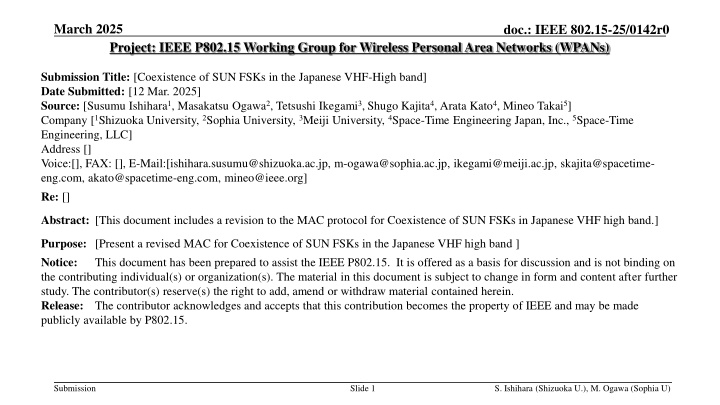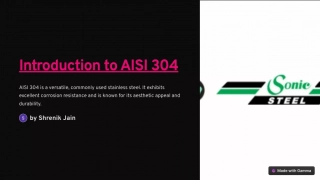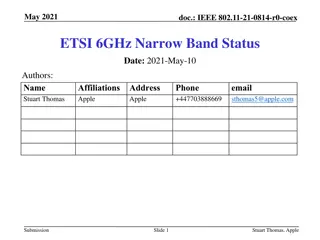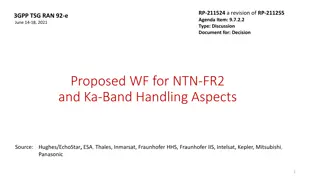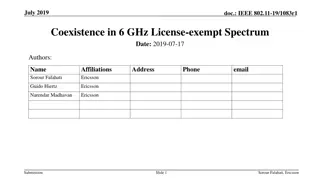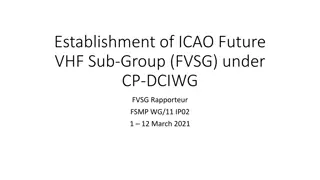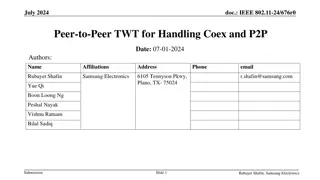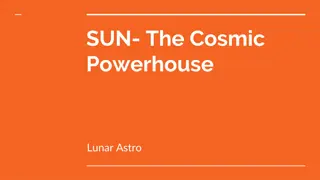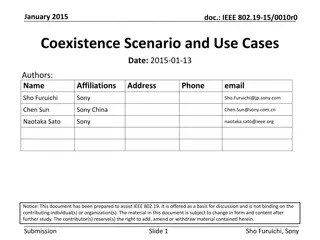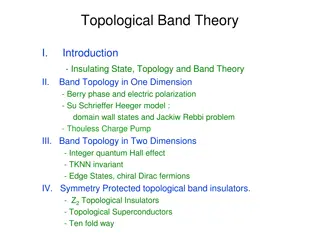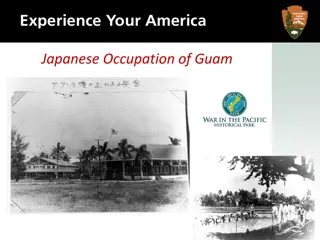Coexistence of SUN FSKs in Japanese VHF-High Band
This document revises the MAC protocol for the coexistence of SUN FSKs in the Japanese VHF-High band, focusing on enhancing communication systems for public safety applications. It addresses modulation, channel parameters, and challenges in CCA in the VHF-high band.
Download Presentation

Please find below an Image/Link to download the presentation.
The content on the website is provided AS IS for your information and personal use only. It may not be sold, licensed, or shared on other websites without obtaining consent from the author.If you encounter any issues during the download, it is possible that the publisher has removed the file from their server.
You are allowed to download the files provided on this website for personal or commercial use, subject to the condition that they are used lawfully. All files are the property of their respective owners.
The content on the website is provided AS IS for your information and personal use only. It may not be sold, licensed, or shared on other websites without obtaining consent from the author.
E N D
Presentation Transcript
March 2025 doc.: IEEE 802.15-25/0142r0 Project: IEEE P802.15 Working Group for Wireless Personal Area Networks (WPANs) Submission Title: [Coexistence of SUN FSKs in the Japanese VHF-High band] Date Submitted: [12 Mar. 2025] Source: [Susumu Ishihara1, Masakatsu Ogawa2, Tetsushi Ikegami3,Shugo Kajita4, Arata Kato4, Mineo Takai5] Company [1Shizuoka University, 2Sophia University, 3Meiji University, 4Space-Time Engineering Japan, Inc., 5Space-Time Engineering, LLC] Address [] Voice:[], FAX: [], E-Mail:[ishihara.susumu@shizuoka.ac.jp, m-ogawa@sophia.ac.jp, ikegami@meiji.ac.jp, skajita@spacetime- eng.com, akato@spacetime-eng.com, mineo@ieee.org] Re: [] Abstract: [This document includes a revision to the MAC protocol for Coexistence of SUN FSKs in Japanese VHF high band.] Purpose: [Present a revised MAC for Coexistence of SUN FSKs in the Japanese VHF high band ] Notice: This document has been prepared to assist the IEEE P802.15. It is offered as a basis for discussion and is not binding on the contributing individual(s) or organization(s). The material in this document is subject to change in form and content after further study. The contributor(s) reserve(s) the right to add, amend or withdraw material contained herein. Release: The contributor acknowledges and accepts that this contribution becomes the property of IEEE and may be made publicly available by P802.15. Submission Slide 1 S. Ishihara (Shizuoka U.), M. Ogawa (Sophia U)
March 2025 doc.: IEEE 802.15-25/0142r0 Background Japanese VHF-High Band The Ministry of Internal Affairs and Communications (MIC) is in the process of initial round of rule- making to introduce Narrowband IoT Communication Systems in the Japanese VHF-High band (170 177.5 and 217.5 222 MHz). One of their primary use cases is public safety applications including disaster response and recovery operations. SUN FSK and SUN OFDM already defined in other frequency bands are being considered as the foundation for the initial rules [1]. In [2], Kajita, et al., proposed a partial proposal on adding SUN FSK to the Japanese VHF-High band (IEEE 802.15-25/007r2) . This partial proposal aims to extend the existing SUN FSK MCSs, which are supported by many off- the-shelf radio modules, to two Japanese VHF bands where the use of SUN PHYs has not yet been defined. Submission Slide 2 S. Ishihara (Shizuoka U.), M. Ogawa (Sophia U)
March 2025 doc.: IEEE 802.15-25/0142r0 Proposed Modulation and Channel Parameters for the VHF-High Band (Citation from [2]) Two data rates are defined for each channel spacing in the VHF-High Band. Both rates are modulated with 2-FSK for the 12.5 kHz channel spacing, where the lower rate is defined for long-range communications. For all other channel spacings, the lower rate utilizes 2-FSK while the higher rate uses 4-FSK. The 4-FSK modulation requires a higher SNR but delivers a higher data rate within the same bandwidth. Operating mode Frequency band (MHz) Parameter #1 #2 #3 #5 #7 #9 #11 Data rate (kb/s) 5 10 20 40 75 150 300 Modulation 2-FSK 2-FSK 2-FSK 2-FSK 2-FSK 2-FSK 2-FSK Modulation index 0.5 0.5 0.5 0.5 0.5 0.5 0.5 Channel spacing(kHz) 12.5 12.5 25 50 100 200 400 170 177.5 #4 #6 #8 #10 #12 217.5 222 Data rate (kb/s) 25 50 100 200 400 Modulation 4-FSK 4-FSK 4-FSK 4-FSK 4-FSK Modulation index 0.33 0.33 0.33 0.33 0.33 Channel spacing(kHz) 25 50 100 200 400 Submission Slide 3 S. Ishihara (Shizuoka U.), M. Ogawa (Sophia U)
March 2025 doc.: IEEE 802.15-25/0142r0 Problem in CCA in the SUN FSK Japanese VHF high band In part of the VHF-high band, Energy detection (ED)-based CCA does not work due to severe out-of-band emission from the neighboring service. Carrier sense (CS)-based CCA is effective for media access control with other devices that use the same channel and the same modulation. However, other services that share the same operation frequency and use different modulation and bandwidth may exist. Energy detection (ED) with a sufficiently high threshold will work to avoid contention with such services. Ego Channel Operating Mode #1 (5 kbps/Channel Spacing 12.5 kHz) Co-Existing Channel covering the ego channel E.g. Operating Mode #9 (150 kbps/Channel Spacing 200 kHz) or Other services Carrier Sense CCA Freq. Energy Detection (ED) based CCA Submission Slide 4 S. Ishihara (Shizuoka U.), M. Ogawa (Sophia U)
March 2025 doc.: IEEE 802.15-25/0142r0 Key Ideas Combination of ED (Mode 1) and CS-based (Mode 2) CCA. Problem: It leads to long lead time before the frame transmission. The device needs to change its bandwidth to perform carrier sense for the specified channel and energy detection in the wider bandwidth covering the channel. The switching time for changing the bandwidth is required. The original CSMA-CA of IEEE 802.15.4 leads to low throughput in congested channels. Use of suspendable CSMA-CA introduced in IEEE 802.15.4-2024. Suspendable CSMA-CA enables CCA during backoff slots to quickly detect the channel BUSY and avoids frame transmission failure especially in highly congested situations. Submission Slide 5 S. Ishihara (Shizuoka U.), M. Ogawa (Sophia U)
March 2025 doc.: IEEE 802.15-25/0142r0 IEEE 802.15.4 CSMA-CA IEEE 802.15.4 CSMA-CA does not perform carrier sense to minimize power consumption until the CCA (Clear Channel Assessment) period just before transmission, while IEEE 802.11 CSMA/CA always performs carrier sense during the backoff slots. Cited from IEEE 802.19-25/0006r0 [4] Submission Slide 6 S. Ishihara (Shizuoka U.), M. Ogawa (Sophia U)
March 2025 doc.: IEEE 802.15-25/0142r0 IEEE 802.15.4 CSMA-CA leads to low throughput IEEE 802.15.4 CSMA-CA does not suspend backoff during the backoff slots. CCA Busy is found after the backoff slots. If the network is congested, Number of Backoffs (NB) tends to reach the specified threshold macMaxCSMABackoffs, and leads to backoff failure. This leads to low throughput [4]. Cited from IEEE 802.19-25/0006r0 [4] Submission Slide 7 S. Ishihara (Shizuoka U.), M. Ogawa (Sophia U)
March 2025 doc.: IEEE 802.15-25/0142r0 Suspendable CSMA-CA introduced in IEEE 802.15.4-2024 [3] If CCA is busy during the backoff delay period, the backoff timer shall be suspended until sensing the channel indicates that the channel is clear or macSuspendedCsmaMaxTime is exceeded. Upon CCA detecting clear, the backoff time shall resume. If macSuspendedCsmaMaxTimeis exceed, backoff ends in Failure and CSMA-CA algorithm terminates with a channel access failure. Cited from IEEE 802.19-25/0006r0 [4] Submission Slide 8 S. Ishihara (Shizuoka U.), M. Ogawa (Sophia U)
March 2025 doc.: IEEE 802.15-25/0142r0 Proposed MAC Strategy for Japanese VHF-High band ED (Mode 1) and CS-based (Mode 2) CCA + Suspendable CSMA-CA After the carrier sense-based CCA, perform ED-based CCA. If the final CCA succeeded, the device starts the frame transmission. Other Devices operating in different modulation Data Tx Other Devices operating in the same channel Data Tx TX Request Time TX-Data Busy CCA (ED) CCA (CS) Active Carrier Sense If fails, restart from CS backoff Switch to ED in the wider bandwidth CCA to TX Turn Around Suspendable CSMA/CA Submission Slide 9 S. Ishihara (Shizuoka U.), M. Ogawa (Sophia U)
March 2025 doc.: IEEE 802.15-25/0142r0 Discussion This proposed MAC enables devices working in the proposed SUN FSK in Japanese VHF-High band to detect co-existing transmissions on channels sharing the same frequency band and using different modulation. Additional turn around time is introduced between the carrier sense-based CCA and ED-based CCA. This leads to a long delay before Data TX or detection of BUSY. Suspendable CSMA-CA works to shorten the delay. Issues Selection of the threshold value for ED according to the ED bandwidth The ED bandwidth depends on the standardization process of the VHF-High band. Confirmation for the compatibility with existing devices Parameter configuration Turn around time from the narrow ego channel to the ED mode Turn around time from ED-CCA to TX (on the narrow ego channel) Submission Slide 10 S. Ishihara (Shizuoka U.), M. Ogawa (Sophia U)
March 2025 doc.: IEEE 802.15-25/0142r0 Summary A revised MAC protocol for co-existing of SUN FSKs in Japanese VHF-High band has been presented. We will conduct a simulation study for verifying the effect of the proposed MAC. Submission Slide 11 S. Ishihara (Shizuoka U.), M. Ogawa (Sophia U)
March 2025 doc.: IEEE 802.15-25/0142r0 References [1] Ministry of Internal Affairs and Communications, Consultation on the regulatory rules of the VHF-High Band, (Japanese). [2] S. Kajita, S. Kitazawa, T. Ikegami, S. Ishihara, A. Kato, T. Matsuda, R. Miura, M. Ogawa, M. Takai, M. Uno, Partial proposal on adding SUN FSK to two Japanese VHF bands, DCN: 802.15-25/0007r2. [3] IEEE Standard for Low Rate Wireless Networks, IEEE Std 802.15.4-2024. [4] T. Sumi, Y. Nagai, J. Guo, P. Orlik, K. Parsons, IEEE 802.11ah and IEEE 802.15.4g SUN OFDM PHY Coexistence Simulation for Case 1-3 with Suspendable CSMA/CA, DCN: 802.19-25/0006r0 Submission Slide 12 S. Ishihara (Shizuoka U.), M. Ogawa (Sophia U)
